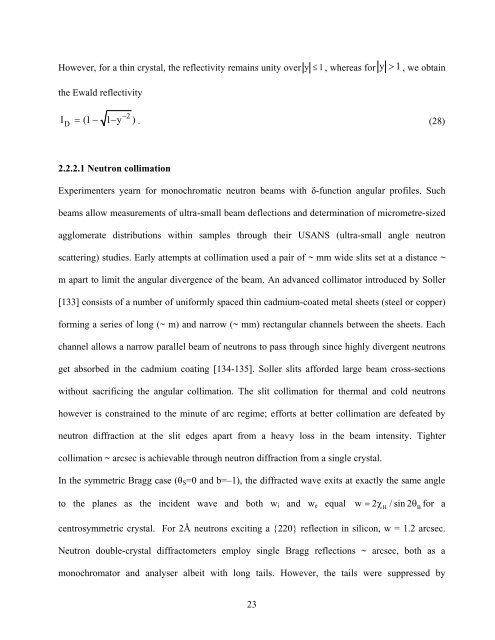PHYS01200804001 Sohrab Abbas - Homi Bhabha National Institute
PHYS01200804001 Sohrab Abbas - Homi Bhabha National Institute
PHYS01200804001 Sohrab Abbas - Homi Bhabha National Institute
Create successful ePaper yourself
Turn your PDF publications into a flip-book with our unique Google optimized e-Paper software.
However, for a thin crystal, the reflectivity remains unity over y 1 , whereas for y 1 , we obtain<br />
the Ewald reflectivity<br />
D<br />
2<br />
I (1 1 y ) . (28)<br />
2.2.2.1 Neutron collimation<br />
Experimenters yearn for monochromatic neutron beams with δ-function angular profiles. Such<br />
beams allow measurements of ultra-small beam deflections and determination of micrometre-sized<br />
agglomerate distributions within samples through their USANS (ultra-small angle neutron<br />
scattering) studies. Early attempts at collimation used a pair of ~ mm wide slits set at a distance ~<br />
m apart to limit the angular divergence of the beam. An advanced collimator introduced by Soller<br />
[133] consists of a number of uniformly spaced thin cadmium-coated metal sheets (steel or copper)<br />
forming a series of long (~ m) and narrow (~ mm) rectangular channels between the sheets. Each<br />
channel allows a narrow parallel beam of neutrons to pass through since highly divergent neutrons<br />
get absorbed in the cadmium coating [134-135]. Soller slits afforded large beam cross-sections<br />
without sacrificing the angular collimation. The slit collimation for thermal and cold neutrons<br />
however is constrained to the minute of arc regime; efforts at better collimation are defeated by<br />
neutron diffraction at the slit edges apart from a heavy loss in the beam intensity. Tighter<br />
collimation ~ arcsec is achievable through neutron diffraction from a single crystal.<br />
In the symmetric Bragg case (θ S =0 and b=–1), the diffracted wave exits at exactly the same angle<br />
to the planes as the incident wave and both w i and w e equal w 2 H / sin 2B<br />
for a<br />
centrosymmetric crystal. For 2Å neutrons exciting a {220} reflection in silicon, w = 1.2 arcsec.<br />
Neutron double-crystal diffractometers employ single Bragg reflections ~ arcsec, both as a<br />
monochromator and analyser albeit with long tails. However, the tails were suppressed by<br />
23
















